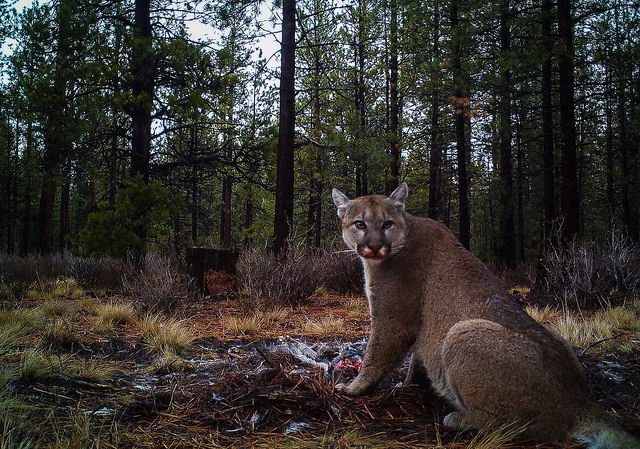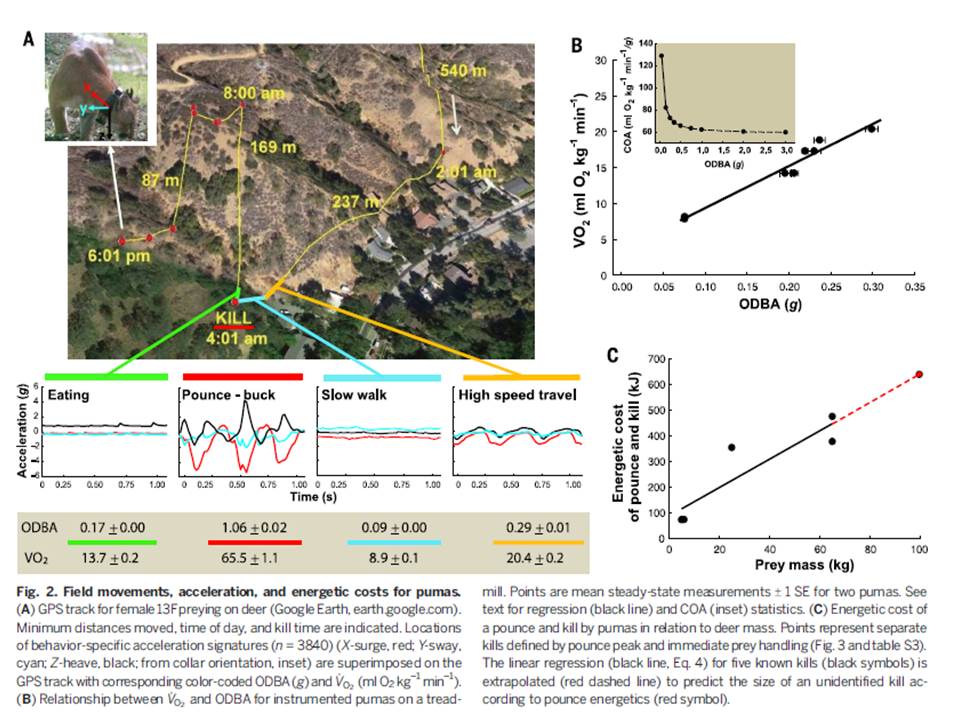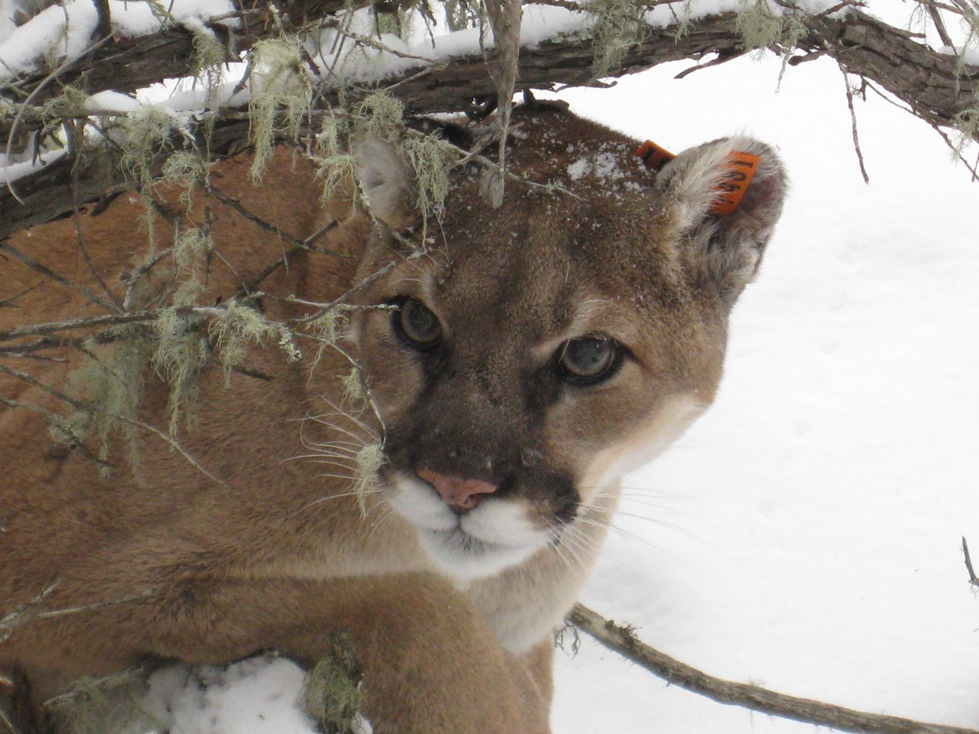- Real-time monitoring and instantaneous energetics are giving scientists access to large amounts of in-situ data on big cats
- SMART collar is calibrated to understand how much energy is expended by a puma during all daily activities based on accelerometer data.
- Pumas spend large amounts of energy on cryptic behaviors (e.g. searching for prey) and spend 2.3 times more energy hunting overall than was previously predicted by ex-situ models.
The popularity of fitness tracking devices has grown enormously in recent years. These devices take in movement and GPS data from throughout your day and spit out graphs and charts of calories burned, steps walked, and locations visited. Now, a group in California has developed a tracking collar for wild pumas (a.k.a. mountain lions or cougars) to track their every step in just as much detail.
The Wilmers Lab, based out of University of California Santa Cruz, has published a pair of papers in Science and Movement Ecology detailing the instantaneous energetics of wild pumas as they hunt and kill prey. The findings give insight into how their hunting techniques may have evolved over time. They were able to develop an advanced collar to measure the energetic output of pumas during hunts.

To collect the data for this study, a team led by Terrie Williams and Chris Wilmers had to develop their own advanced collar and tracking system to measure the energetic output of pumas during hunts. Dubbed SMART – short for Species Movement, Acceleration and Radio Tracking – the 480-gram collar uses a standard GPS/VHF collar to mark positions with GPS every four hours. A three-axis accelerometer and magnetometer attached to the battery case can be programed to monitor activity level and body position at preset increments to save battery life. The researchers could not be reached for comment on details of the collar, including battery life and cost; in the most recent paper, the collars gathered movement data for between 4 and 26 days on wild pumas, although the accelerometer was not switched on continuously during the study period (Wang et. al, 2015).
While producing the collar was itself an engineering achievement, the team also had to conduct calibration studies with captive pumas, training them to walk on a treadmill to get oxygen consumption rates (known in the field as VO2 max). This information was used to translate the accelerometer data into actual energetic costs, measured in kilojoules. This is similar to how a fitness tracker can determine what a person is doing and how many calories they’re burning just from wrist movement data.
By videotaping captive cats wearing a collar, the group was able to refine the accelerometer information even more. As explained in the UC Santa Cruz video below, they amassed a large library of “collar acceleration signatures specific for different behaviors”, including resting, grooming, running and pouncing.
The research group was then able to track in detail the energy expended by and activity of the wild pumas as they moved through rugged terrain to find, hunt and kill their prey. They found that the energetic costs for the cats were 2.3 times greater than what has beenassumed among experts based on indirect energy models.
These findings show just how important stealth attacks are among big cats; they are able to mitigate high hunting costs by matching the strength of their pounce to the size of their prey. The researchers were also able to quantify the energetic savings of stalking, which reduces the amount of time and distance spent chasing after prey and is a hunting method seen in many cat species. This differs significantly from other carnivores, such as wild dogs, which can chase in packs and run their prey down over many kilometers.

The authors also point to the importance of sufficient prey bases. In rugged terrain, more of a puma’s energy is spent looking for prey than previously thought. The effort they use to jump over rocks and run up steep slopes while pursuing prey can add up, especially when a hunt typically takes around two hours. It seems that doing the long-term legwork of looking for food costs much more than sealing the deal.
As sensors become smaller and cheaper, these types of detailed, data-driven activity studies are of growing interest to those hoping to better understand how keystone species interact with their environment. In a similar study, a team from the same lab at UC Santa Cruz was able to determine the metabolic rate and track the energy expenditure of cheetahs using radio collars and heavy hydrogen and oxygen atoms injected into their bloodstream. As Dr. Wilmers terms it, we are now in the Golden Age of Bio-Logging (Wilmers et. al, 2015).

“This is an exciting leap forward in quantifying the energetic expenditures of wild mountain lions”, Mark Elbroch, director of the Teton Cougar Project, said in an interview with National Geographic on the puma study. The collar, he explained, will help biologists better understand the energy expenditures of big cats and other carnivores as they deal with both ecological and human stress associated with climate and land-use changes.
Citations:
Wang Y., Nickel B., Rutishauser M., Bryce C.M., Williams T.M., Elkaim G., Wilmers C.C. (2015) Movement, resting, and attach behaviors of wild pumas are revealed by tri-axial accelerometer measurements. Movement Ecology. 3(2)
Williams T.M., Wolfe L., Davis T., Kendall T., Richter B., Wang Y., Bryce C., Elkaim G.H., Wilmers, C.C. (2014) Instantaneous energetics of puma kills reveal advantage of felid sneak attacks. Science 345(6205):81-86.
Wilmer, C.C., Nickel B., Bryce C.M., Smith J.A. Wheat R.E., Yovovich V. (2015) The golden age of bio-logging: how animal-borne sensors are advancing the frontiers of ecology. Ecology 97(7):1741-1753